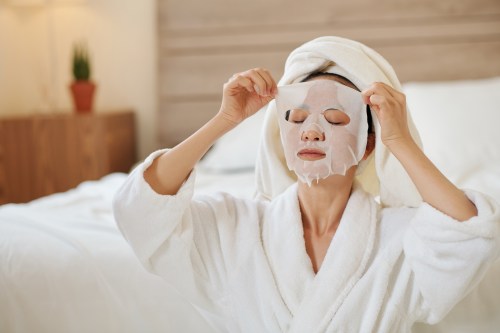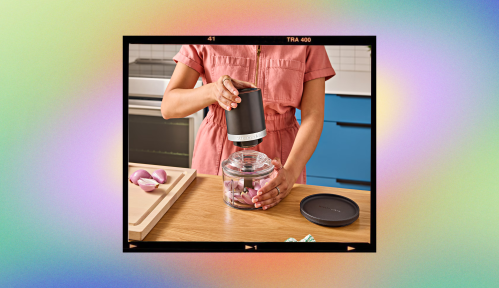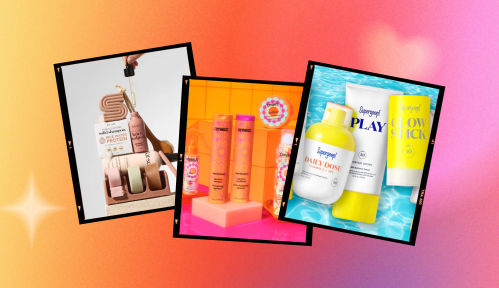Waking up in the morning can be hard enough—now TikTokers want us to ‘shed’, too? The newest trend to hit the app is called the "morning shed"—and it has creators documenting their oddly satisfying morning transformations. With millions of views and counting, these videos show people methodically peeling off face masks, lifting under-eye patches, unraveling heatless curls, and more—all in the name of waking up as flawless as Beyoncé.
Experts in This Article
board-certified dermatologist at Skin Wellness in Birmingham, Alabama
board-certified dermatologist at UnionDerm
board-certified dermatologist and founder of Miami Derm
board-certified dermatologist at BH Skin Dermatology
So, it begs the question: Is this elaborate skincare ritual actually worth adding to your likely already-rushed morning routine? We asked the experts to find out if the "morning shed" is a must-do or just another trend that looks better on screen than in real life. Here’s what we learned.
First, what is a morning shed?
Despite what the name suggests, the morning shed isn’t about exfoliating dead skin. Rather, it's the process of applying layers of self-care products and contraptions before going to sleep at night to wake up to a more refreshed and "done up" appearance in the morning, Corey L. Hartman, MD, a board-certified dermatologist and founder of Skin Wellness Dermatology, tells Well+Good. The "shed" part is the big satisfying reveal once these products that supposedly work their magic overnight are removed in the morning.
And we’re not talking about just a face cream—or two—here. According to Robyn Gmyrek, MD, a board-certified dermatologist at UnionDerm, the morning shed process often involves peeling away layer upon layer of overnight treatments. Think potions packed with retinol, vitamin C, and alpha hydroxy acids (AHAs) to stimulate collagen and exfoliate dead skin cells, she explains.
Then, these usually get covered under a blanket of hydrating sheet face masks for maximum absorption. Many followers of the trend also often use eye masks to get more hydration in the under-eye area. But that's not all. “Mouth tape is [sometimes] applied to force nose breathing, and then chin straps to help define the jawline and keep the face tight and slim,” Dr. Gmyrek adds.
Add in the hair treatments, heatless curlers, and bonnet, and by bedtime, you’re essentially wearing a full-face costume and ready for…Halloween?
So, do you actually need a morning shed?
More isn’t always better when it comes to skincare—and an elaborate routine is not necessary to have more hydrated, youthful skin, says Dr. Hartman. “You can achieve that with one to two products each evening,” he adds.
Anna Chacon, MD, FAAD, a board-certified dermatologist and founder of Miami Derm, agrees: “Depending on your individual skin’s needs, too many layers can do the opposite of what you’re trying to achieve. A consistent, simple routine can accomplish the same or even better results if the products are chosen correctly for your skin goals,” she notes.
For skincare products to work well, the ingredients need to be small enough and at the right pH level. Take hyaluronic acid, for example—a super-popular moisturizing ingredient. Its molecular weight (the size of its molecules) determines how well it actually penetrates your skin.1 Smaller molecules can go in deeper, while larger ones mostly sit on the surface. When you pile on multiple products, you might be creating traffic jams that prevent ingredients from getting where they need to go to be truly effective.
Plus, there’s no scientific evidence that the morning shed works, adds Dr. Gmyrek. She explains that our skin has a protective barrier of four interconnected layers—physical, chemical, microbiological, and immunological—that all work together to protect it.2 “The outer layer of our skin keeps the good stuff in and the bad stuff out,” she says. It also protects us from toxins, harmful chemicals, infections, and UV radiation, and holds onto our natural moisture by preventing water loss through the skin, she adds.
Using too many active ingredients can actually weaken the skin’s barrier, causing dryness, irritation, and sensitivity (more on this later), according to Asmi Berry, DO, FAAD, a board-certified dermatologist at BH Skin Dermatology. Layering product over product not only can keep the ingredients from doing their work, but it can actually prevent your skin from absorbing them effectively, she explains.
And when it comes to the benefits? Well, the morning shed might not produce the dramatic results you might be hoping for. That enviable post-morning-shed-glow is often due to temporary hydration plumping up the skin rather than an actual long-term transformation, Dr. Berry notes.
Are there any side effects of doing the morning shed routine?
Yes—and it’s more than just a hit to your wallet. These products might work great solo, but stack too many, and they can cancel each other out or leave your skin irritated. Here’s what our experts are concerned about when it comes to the trend:
- Skin irritation: Over-exfoliation and skin barrier damage are major risks, says Dr. Berry. Combining too many acids, retinoids, or harsh active ingredients can strip the skin, leading to redness and peeling.
- Clogged pores: On top of irritation, you might notice breakouts from combining too many comedogenic products, explains Dr. Chacon.
- Dryness: Some products like sheet masks aren’t meant for overnight use, and can actually dry out the skin by pulling moisture away instead of locking it in, Dr. Gmyrek points out.
- Safety concerns: Using mouth tape incorrectly can interfere with breathing, Dr. Chacon adds. This is especially true if you have an existing health condition that causes breathing problems. Plus, a tight chin strap might restrict blood flow and damage your skin if worn too snugly throughout the night, notes Dr. Gmyrek.
- Sleep issues: Heavy, scented, or uncomfortable products can make it harder to fall and stay asleep, Dr. Berry notes. Plus, the time spent applying and removing layers can cut into your sleep (not to mention potential disruptions during the night from all the products on your face, hair, and body), says Dr. Hartman.
- Wasted product and money: Dr. Hartman points out that you could be spending money on products that won’t be effective when stacked on top of each other.
Dermatologist-approved alternatives to the morning shed
If there’s one thing all our experts agree on, it’s to ditch the complicated routine and embrace simplicity. Just one active product and sunscreen in the morning, and one active product and moisturizer at night are all you need, says Dr. Gmyrek.
But if you want to use more than one active ingredient, instead of layering multiple individual products that might not work well together, Dr. Gmyrek recommends looking for a combination product that has them all professionally mixed in already. “This way you know that the ingredients were formulated and tested for stability and effectiveness,” she notes.
So, what’s worth keeping in your skincare routine? Dr. Hartman recommends sticking to the essentials, and retinol is at the top of his list for improving skin appearance.3 For nighttime, he suggests the Clinique Smart Night Clinical MD Multi-Dimensional Repair Treatment Retinol ($79) to reduce fine lines and wrinkles, as it delivers deep hydration. Mother Science Retinol Synergist ($96), which pairs retinol with malassezin, is another go-to, especially if you have sensitive skin, he says.
To lock in moisture, an overnight cream, with ingredients like ceramide and hyaluronic acid, can give you good hydration and repair the skin barrier while you sleep, Dr. Gmyrek explains.4 An example is the CeraVe Skin Renewing Night Cream ($16). It’s packed with ceramides, hyaluronic acid, and peptides, giving you the benefits of those ingredients in one formula without the complicated routine. Another option? The Cetaphil Healthy Renew Night Cream ($18), which has peptides and vitamins B3 (aka niacinamide) and B5 (aka pantothenol), says Dr. Hartman.
And to strengthen your skin barrier, look for ingredients that actually work, Dr. Gmyrek says. These include ceramides (hello again!) to restore moisture, niacinamide to calm inflammation and repair the barrier, glycerin to hydrate, colloidal oatmeal to soothe irritation, and plant oils like jojoba, coconut, almond, and argan oil to nourish and protect.5 Gentle AHAs like lactic acid can also boost ceramide production to strengthen the skin’s defenses.
Keep in mind: Skincare is also about lifestyle. Dr. Gmyrek warns against jumping on every new skincare trend out of FOMO. Instead, focus on the basics: eating antioxidant-rich foods (like berries and leafy greens), cutting back on sugar and alcohol, getting enough protein, exercising, and being consistent with sunscreen. "Reapply [sunscreen] every four hours! Broad spectrum, SPF 30 or more,” she emphasizes.
The bottom line
The "morning shed" might look oh-so-satisfying to watch, but piling on layers of skincare overnight isn’t necessarily better for your skin. Experts agree that a simple, well-chosen routine can be just as effective without the risk of irritation, clogged pores, sleep issues, or making your partner do a double-take in the middle of the night.
Instead of overloading your skin, focus on a solid nighttime routine with one or two key products, like a targeted treatment (think retinol or niacinamide) and a good moisturizer. But if you still want to try the morning she for yourself, be sure to use the products as directed to avoid skin issues. All in all, the best skincare routine isn’t the one with the most steps—it’s the one with smart ingredient choices that you’ll actually stick with.
- Juncan, Anca Maria et al. “Advantages of Hyaluronic Acid and Its Combination with Other Bioactive Ingredients in Cosmeceuticals.” Molecules (Basel, Switzerland) vol. 26,15 4429. 22 Jul. 2021, doi:10.3390/molecules26154429 ↩︎
- Rajkumar, Jeffrey et al. “The Skin Barrier and Moisturization: Function, Disruption, and Mechanisms of Repair.” Skin pharmacology and physiology vol. 36,4 (2023): 174-185. doi:10.1159/000534136 ↩︎
- Quan, Taihao. “Human Skin Aging and the Anti-Aging Properties of Retinol.” Biomolecules vol. 13,11 1614. 4 Nov. 2023, doi:10.3390/biom13111614 ↩︎
- Draelos, Zoe Diana et al. “Ceramide-Containing Adjunctive Skin Care for Skin Barrier Restoration During Acne Vulgaris Treatment.” Journal of drugs in dermatology : JDD vol. 22,6 (2023): 554-558. doi:10.36849/JDD.7142 ↩︎
- Boo, Yong Chool. “Mechanistic Basis and Clinical Evidence for the Applications of Nicotinamide (Niacinamide) to Control Skin Aging and Pigmentation.” Antioxidants (Basel, Switzerland) vol. 10,8 1315. 21 Aug. 2021, doi:10.3390/antiox10081315 ↩︎
Sign Up for Our Daily Newsletter
Get all the latest in wellness, trends, food, fitness, beauty, and more delivered right to your inbox.
Got it, you've been added to our email list.










